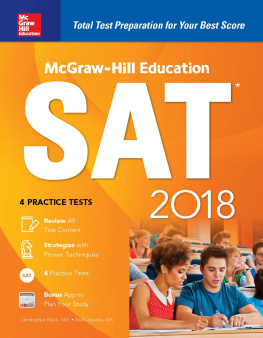TOP 15 THINGS YOU NEED TO KNOW ABOUT LITERATURE
This feature provides a checklist of the 15 reading strategies and literary elements that are most likely to appear in questions and answer choices on the SAT Literature Test.
The list provides you with a hint about how to answer a question about each element or strategy. Two sample questions are provided, showing you how questions relating to each element or strategy are likely to be worded.
See "Test-Taking Strategies for the Literature Test" for specific types of questions and how to approach them.
1. CHARACTER/MOTIVATION
Understand why a character does or says something and what a character may be thinking or feeling based on clues in the passage. Be able to locate specific words or phrases in a passage that support your interpretation.
Examples
Which best characterizes the speaker?
Which is NOT a reasonable conclusion to draw about the captain?
2. SETTING
Know how to identify a time or place based on clues in a passage or poem, how setting relates to mood or tone, and how setting affects characters. Look for hints in the selection.
Examples
The setting of this passage is best described as
How does the setting affect the mood of the poem?
3. THEME
Know how to identify the theme of a passage or poem. Remember that the theme of a literary work is its implied messagea universal statement about life. Because themes are usually implied, not stated directly, you may have to spend a little extra time on a theme question. Use specific details in the passage to help identify the theme.
Examples
Which major theme does the passage address?
Which best sums up the speaker's message to the beloved?
4. TONE
Be able to describe the tone of a passage or poem, or how a specific extract from the poem or passage affects the tone. Remember that the tone of a work is the author's attitude toward the subject; do not confuse tone with mood, which is the impact of the work on the reader.
Examples
Which best describes the tone of the passage?
The poet uses the words "dark," "night," "shade," and "shadow" in order to achieve a tone of
5. SYMBOLISM
Know how to identify the larger symbolic importance of a character, object, or action from the passage or poem. Because authors usually imply what something symbolizes rather than stating this information directly, questions about symbolism can take a little more time to answer. Use specific details in the passage to understand the symbolism of a passage.
Examples
When the author says that Raggles sees a city as "an individual conglomeration of life," he suggests that the city symbolizes which of the following? What does the black-and-red color scheme of the suite's seventh room symbolize?
6. ALLUSIONS
Recognize allusionsreferences to historical events, great works of literature, and art. By definition, allusions are unexplained; the author takes for granted that the reader will recognize an allusion. The strategy of eliminating obvious wrong answers can come in handy when you are not sure of the right answer to an allusion question.
Examples
The line "I do not find / The Hanged Man" is an allusion to which of the following?
When the author says that Jim was "tilting at windmills," he is alluding to
7. USING CONTEXT CLUES TO DEFINE VOCABULARY
Use context clues and knowledge of roots and affixes to define an unfamiliar vocabulary word. Make sure to identify the word's part of speech; this can also help you eliminate wrong choices. You can also use context clues when the word in the question is familiar but has more than one definition.
Examples
The word "concatenation" is best defined as
In what sense does the speaker use the word "forward"?
8. AUTHOR'S PURPOSE
Be able to identify the author's main purpose in writing a speech or passage. In order to determine why an author included a particular detail, think about the effect that detail had on you and then find the answer choice that best matches your reaction.
Examples
The author includes the information in the last paragraph in order to Why does the author include the final sentence, when its ideas were already expressed in the previous sentence?
9. SONNET
Be sure you know that a sonnet is a 14-line poem in iambic pentameter, and that when you see a sonnet that deviates from the standard sonnet form, you can identify what makes it different. This book contains a few sonnets in the practice tests and other sample poems that you can examine as examples.
Example
The poem meets all of the usual standards for a sonnet EXCEPT
10. METER AND RHYTHM
In poetry, meter refers to the number of metric feet per line, and rhythm refers to the pattern of stressed and unstressed syllables. Be sure not to confuse these terms with one another. Practice scanning verse so that you will be confident in your ability to identify rhythm and meter.
Examples
Which best describes the relationship between the poem's main theme and its rhythm?
Which best describes the effect of the poem's meter?
11. INTERPRETING FIGURATIVE LANGUAGE
Be able to interpret similes, metaphors, and examples of personification. The test is more likely to ask you to interpret a simile or a metaphor than to simply identify one. When interpreting figurative language, look for the answer choice that is best supported by the overall meaning of the passage or poem.
Examples
Which best describes the effect of the speaker's comparison of the "halfdeserted streets" "that follow like a tedious argument / Of insidious intent"? The metaphor "white sails" refers to
12. UNDERSTANDING ARCHAIC LANGUAGE
Make sure that you understand archaic and old-fashioned language, such as occurs in the poems and plays of Shakespeare. (Roughly 60 percent of the test questions will be on literary selections written before 1900.)
Examples
Which of the following best paraphrases the lines "More will I do; / Though all that I can do is nothing worth, / Since that my penitence comes after all, / Imploring pardon"?
When the speaker says "Then if for my love thou my love receivest, / I cannot blame thee for my love thou usest," he means
13. MAKING INFERENCES
Know how to make an inference about why a character does something, what a character may be thinking, why an author included a particular detail, and so forth. Be able to weigh the clues in the passage and use surrounding details to find the best answer.
Examples
When the speaker says "I have measured out my life with coffee-spoons," he means
The information in the second paragraph allows you to conclude which of the following?
14. FINDING THE MAIN IDEA
Be able to identify the main idea of a passage. To do this, it is best to ask yourself the question "What was this passage about?" Look among the answer choices for the one that best matches your answer to this question. It may be more difficult to identify an implied main idea than one that is stated directly. (HINT: Many authors state the main idea at the beginning or end of a paragraph.)
Examples
Which sentence from the passage best states its main idea?
Next page




